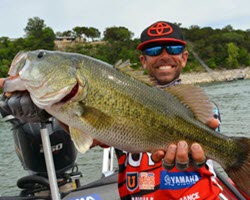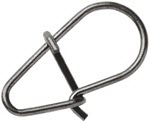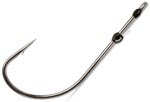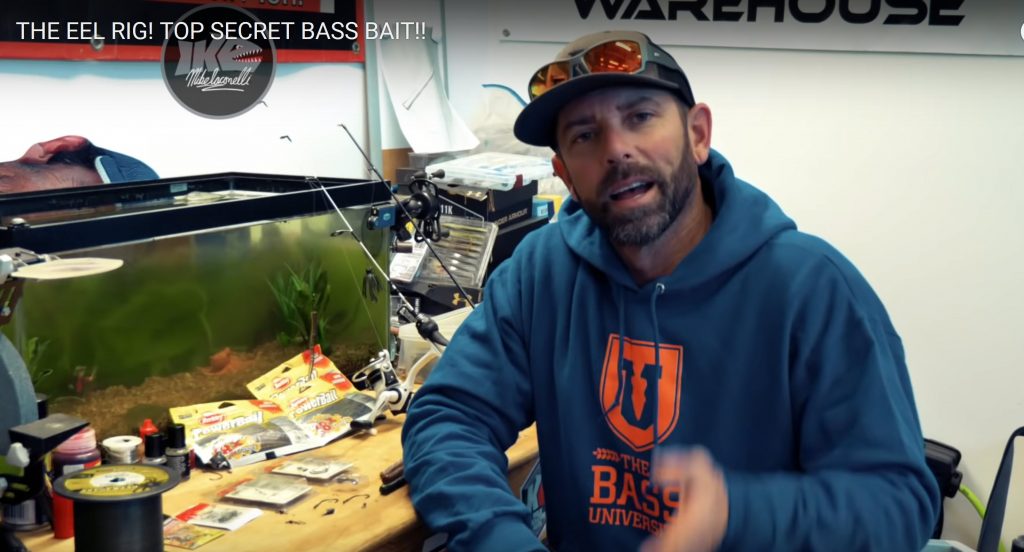
OK, this is a great rig for when the bite is a little slow and they’re short striking your lure. Basically it’s a cross or a hybrid between a Neko rig and a chicken rig. That sounds crazy, I know. But as you read on and figure out what I’m doing it’ll all make sense to you.
Here’s what you’re going to need to build one:
- A snap swivel or a snap and a swivel. I use VMC Crankbait Snaps for this. They’re a little wider so they work a little better. And I like black. It’s less intrusive.

VMC Crankbait Snaps - A drop shot sinker, any style or shape. The main thing here is that it must have a round, closed eye on top. Do not use one with a pinch style connector on top.
- A short — 2 feet — piece of 15 to 30-pound-test braid. I like 20-pound-test for my eel rigs. Color doesn’t matter because it’ll be inside the plastic.
- A Neko hook with a bait keeper on the shank. The VMC Finesse Neko Hook is perfect. I carry sizes between a No. 2 and a 1/0. I switch them around depending on the size of the bait I’m using. The main thing about this hook is that it has a bait keeper on the shank. That really helps hold the plastic in place.

VMC Finesse Neko Hook - A straight tail worm or a plastic stickbait. The perfect bait for this is the Berkley Powerbait Flute Worm, and I like both sizes. The thing here is that it has o-rings on it that help you measure where you want the hook to come out.
Here’s how we’re going to build one:
We’re going to do this in a step-by-step process, but before we do I’m going to tell you what you’re building so you have an idea what’s happening.
When you’re done, the eel rig will have a sinker attached to the snap on the swivel. A piece of braid will come off the snap and run through the worm to a Texas rigged hook about two-thirds of the way back into the plastic.
- Start by tying a barrel swivel or snap swivel to your main line with a Palomar knot. Attach the snap to the swivel if that’s necessary.
- Then clip your drop shot weight to the snap — not to the swivel.
- Once you’ve done that attach a short piece of braid to the snap. Tie it right in the crotch of the snap. Keep your line away from the swivel. I like a Palomar knot for this. You can measure how much length you need by using the plastic as a guide and then adding enough line to make your final knot.
- Almost last, tie your hook to the far end of your line. I snell this connection. A Palomar is doable but a snell will give you better hooksets.
- The real last, run the hook through the bait but instead of pulling it out right away like you usually do go two-thirds of the way back through the worm. Basically you’re going to thread the braid through the worm. Pull it out and Texas rig it like you would any other bait. It’ll take you a time or two to get the length of the braid right and to pull the hook back that far but it will happen.
Here’s how you’re going to catch fish with it:
When you’re done you have an eel-like lure with a weight hanging off the bottom at the head. The worm stays flexible and the hook is in the back part of the worm. Beyond that it’ll drop down like a Neko rig before you snake it along the bottom.
And, you can change the weight and the rate of fall as the conditions change — in a matter of seconds. All you have to do is take the old weight off and clip the new one on.
I’m telling you fellow bass-heads, the eel rig is the real deal. Practice building it this winter so you’re ready to go this spring. You won’t be sorry.
_________________________________________
Listen to Mike walk you thought the process:

Like Ike on Facebook, and follow him on Instagram for fishing and fun content.
Subscribe to Mike’s YouTube channel, Going Ike, to ensure you see every adventure video.
Return to Mike Iaconelli’s website
















